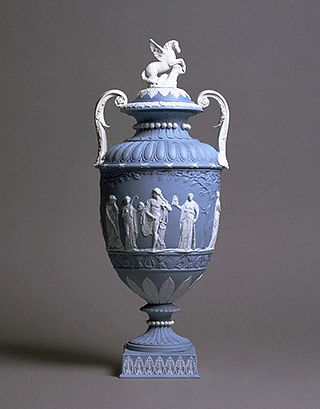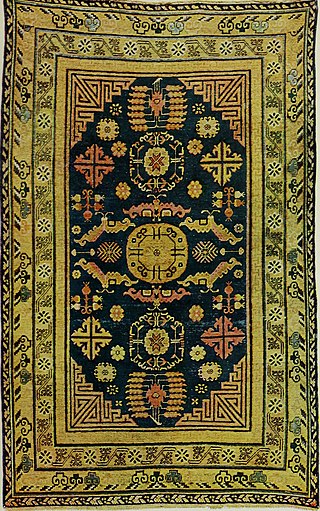Notes
- ↑ 'Robin Reilly', WorldCat. Retrieved 8 August 2023.
- ↑ Bevis Hillier, 'Collecting', The Times (29 November 1973), p. vi.
Robin Reilly (born 1928) is a British writer. [1] He authored works on the Wedgwood company and military history. He served as a senior director of Wedgwood's for 12 years. [2]

Alan Alexander Milne was an English writer best known for his books about the teddy bear Winnie-the-Pooh, as well as for children's poetry. Milne was primarily a playwright before the huge success of Winnie-the-Pooh overshadowed all his previous work. He served in both world wars, as a lieutenant in the Royal Warwickshire Regiment in the First World War and as a captain in the Home Guard in the Second World War.

Josiah Wedgwood was an English potter, entrepreneur and abolitionist. Founding the Wedgwood company in 1759, he developed improved pottery bodies by systematic experimentation, and was the leader in the industrialisation of the manufacture of European pottery.

Captain Robert von Ranke Graves was an English poet, soldier, historical novelist and critic. His father was Alfred Perceval Graves, a celebrated Irish poet and figure in the Gaelic revival; they were both Celticists and students of Irish mythology.

John Flaxman was a British sculptor and draughtsman, and a leading figure in British and European Neoclassicism. Early in his career, he worked as a modeller for Josiah Wedgwood's pottery. He spent several years in Rome, where he produced his first book illustrations. He was a prolific maker of funerary monuments.

Thomas Whieldon was an English potter who played a leading role in the development of Staffordshire pottery.

Josiah Spode was an English potter and the founder of the English Spode pottery works which became famous for the high quality of its wares. He is often credited with the establishment of blue underglaze transfer printing in Staffordshire in 1781–84, and with the definition and introduction in c. 1789–91 of the improved formula for bone china which thereafter remained the standard for all English wares of this kind.

Spode is an English brand of pottery and homewares produced in Stoke-on-Trent, England. Spode was founded by Josiah Spode (1733–1797) in 1770, and was responsible for perfecting two important techniques that were crucial to the worldwide success of the English pottery industry in the 19th century: transfer printing on earthenware and bone china.

Creamware is a cream-coloured refined earthenware with a lead glaze over a pale body, known in France as faïence fine, in the Netherlands as Engels porselein, and in Italy as terraglia inglese. It was created about 1750 by the potters of Staffordshire, England, who refined the materials and techniques of salt-glazed earthenware towards a finer, thinner, whiter body with a brilliant glassy lead glaze, which proved so ideal for domestic ware that it supplanted white salt-glaze wares by about 1780. It was popular until the 1840s.

George Morgan Thomson, Baron Thomson of Monifieth, was a British politician and journalist who served as a Labour MP. He was a member of Harold Wilson's cabinet, and later became a European Commissioner.

Jasperware, or jasper ware, is a type of pottery first developed by Josiah Wedgwood in the 1770s. Usually described as stoneware, it has an unglazed matte "biscuit" finish and is produced in a number of different colours, of which the most common and best known is a pale blue that has become known as "Wedgwood blue". Relief decorations in contrasting colours are characteristic of jasperware, giving a cameo effect. The reliefs are produced in moulds and applied to the ware as sprigs.

Wedgwood is an English fine china, porcelain and luxury accessories manufacturer that was founded on 1 May 1759 by the potter and entrepreneur Josiah Wedgwood and was first incorporated in 1895 as Josiah Wedgwood and Sons Ltd. It was rapidly successful and was soon one of the largest manufacturers of Staffordshire pottery, "a firm that has done more to spread the knowledge and enhance the reputation of British ceramic art than any other manufacturer", exporting across Europe as far as Russia, and to the Americas. It was especially successful at producing fine earthenware and stoneware that were accepted as equivalent in quality to porcelain, though considerably less expensive.
Peter George James Jenkins was a British journalist and Associate Editor of The Independent. During his career he wrote regular columns for The Guardian, The Sunday Times as well as The Independent.

David John Murray Wright was an author and "an acclaimed South African-born poet".

Paul Hereford Oliver MBE was an English architectural historian and writer on the blues and other forms of African-American music. He was equally distinguished in both fields, although it is likely that aficionados of one of his specialties were not aware of his expertise in the other. He wrote some of the first scholarly studies of blues music, and his commentary and research have been influential.

Ernle Dusgate Selby Bradford was a noted 20th-century British historian specializing in the Mediterranean world and naval topics. He was also an authority on antique jewellery and was the founder editor of the Antique Dealers and Collector's Guide.
Events from the year 1763 in Great Britain.

Emma Crewe was a British artist known for her designs for Josiah Wedgwood, and for her botanical art.

Dame Cicely Veronica Wedgwood, was an English historian who published under the name C. V. Wedgwood. Specializing in the history of 17th-century England and continental Europe, her biographies and narrative histories are said to have provided a clear, entertaining middle ground between popular and scholarly works.

Henry Webber (1754–1826) was an English sculptor and modeller.

A gul is a medallion-like design element typical of traditional hand-woven carpets from Central and West Asia. In Turkmen weavings they are often repeated to form the pattern in the main field.